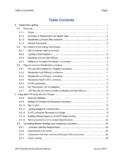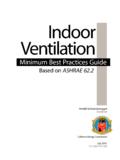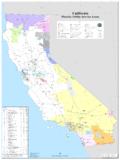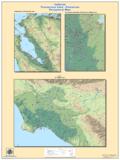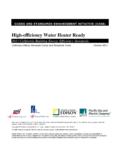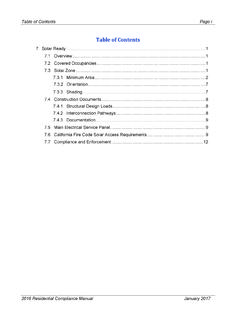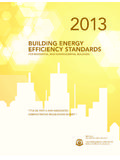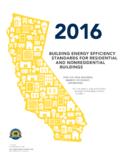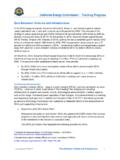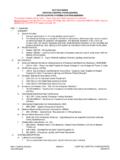Transcription of Residential Lighting - 2016 Title 24 Codes & …
1 2016 Title 24 Codes & Standards Enhancement (CASE) Proposal ()pResidential LightingCEC Pre-rulemaking Workshop June24th2014 CEC Pre-rulemaking Workshop, June 24th, 2014 David Douglass-Jaimes, McGaraghan, Energy - Current Code Requirements All fixtures categorized as high or low efficacy (Table 150 0A)(Table )High EfficacyLow EfficacyPin basedlinearorcompactHighefficacylampsins talledinPinbased linear or compact fluorescentHigh efficacy lamps installed in low efficacy luminairesPulse start metal halideIncandescentHighpressuresodiumMerc uryvaporHigh pressure sodiumMercury vaporGU 24 socketsTrack lightingLED sources certified to the CiiLED sources not certified to thCiiCommissionthe CommissionInduction2 Background - Current Code Requirements Kitchens: at least 50% of Wattage is high efficacy Requires luminaire wattage calculations and luminaire labelling, see S ti130 0 fd t ilSection for details Added low efficacy Lighting : 50 watts for dwelling units 2,500 ft or 100 watts for dwelling units > 2,500 ft if Lighting on dimmer or occupancy sensorC bit li htith20 Wlift f Cabinet Lighting : no more than 20W per linear foot of cabinet Requires a Lighting calculation, see Section Bathrooms:Bathrooms: At least one high efficacy fixture All other fixtures high efficacy or vacancy sensor controlled Garages, Laundry Rooms, and Utility Rooms:gyy High efficacy AND vacancy controlled All other rooms.
2 High efficacy, ORCtlldbdi3 Controlled by dimmer or vacancy sensorTypical Practice Problem StatementHi h ffili htih High efficacy Lighting has been cost effective since the 2005 Standards Adoption of high efficacy Lighting is still lowf Energy savings from low efficacy Lighting with controls is far less than the savings gfrom high efficacy lightingSource: Efficiency Characteristics and Opportunities for New California Homes, 20114pp,Note: Source Watts and not number of fixturesTypical Practice Low Efficacy Residential Lighting 81% of installed watts are low efficacy 62% of installed lamps are low efficacy70% fk tlffi 70% of sockets are low efficacy Based on current Title 24 Standards ~8% of sockets have high efficacy screw-in lamps 8% of sockets have high efficacy screwin lampsHigh EfficacyLow EfficacyAverage Installed n3631602 Watts%19%81%Average Installed to High Efficacy Lighting Quality of high efficacy sources Color quality is a common complaint for CFLs limited high efficacy fixture choices Inflexible and unfamiliar sources GU-24 or pin-base CFLItlLEDl i i Integral LED luminaires Higher costs for currently definedhigh efficacy luminairesefficacy luminaires Higher costs for luminaires Higher costs for replacement lamps6 Higher costs for replacement lampsNew Opportunities High quality.
3 High efficacy LED sources Higher color rendering (90+ CRI) CCT similar to incandescent (2700-3000K)Llif (10+iid ti lli ti) Long life (10+ years in Residential applications) Rapidly decreasing costs Federal and State Lamp Standards Phasing out traditional low efficacy lampsPhasing out traditional low efficacy lamps Scheduled to go into effect earlier in California 2018 than rest of country7 Proposed Code Change: Simplify the Ridti l Li htiStd d Require High EfficacyIlltResidential Lighting Standards In all room types Eliminate low efficacy allowances with controls Relax High Efficacy DefinitionAllow traditional (e g screwbase) socket types but only if Allow traditional ( screw-base) socket types, but only if installed with high quality, high efficacy, JA-8 source All hardwired or GU-24 options in Table remain Recessed Downlights only luminaire type not allowed gyypto use JA-8 compliant screw base lamps JA8 dedicated luminaire, or use quick-connect or Zhaga base Maintain Existing Control Requirements At least one luminaire in Bathrooms, Laundry, Utility Rooms, and Garages must be controlled by vacancy sensor Dimmers or vacancy sensors required for screw-base LED fixtures in all room types other than Kitchens Bathrooms8fixtures in all room types other than Kitchens, Bathrooms, Laundry Rooms, Utility Rooms, and GaragesProposed Code Change Energy Savings Whole House Current Practice 1602 low efficacy watts hours per day average, 621 hours per year988 kWh// it flffili hti 988 kWh/year/unit from low efficacy lightingPotential Energy Savings.
4 625 kWh/yr/unit Potential Energy Savings: 625 kWh/yr/unit Assume 73% savings from downlight requirementAssume60% savings switchingall other Lighting Assume 60% savings switching all other Lighting from low to high efficacy9 Sources: Efficiency Characteristics and Opportunities for New California Homes, 2011; KEMA 2010 Upstream Lighting EvaluationProposed Code Change Cost Effectiveness Whole House Current Practice average low efficacy downlights 21 average non-downlight low efficacy socketsIt l CttiCt $525/h Incremental Construction Cost: $525/home Assumes $ per compliant downlight Projected 2017 cost, based on decreases in LED costs Incrementalcosts even less for LED kits with integral trimringIncremental costs even less for LED kits with integral trim ring Assumes $ per lamp, current 90+ CRI LED lamp Projected 2017 cost, based on decreases in LED costs Avoided cost of trim rings, traditional lamps: $160 ItlMitCt$132/h Incremental Maintenance Costs: -$132/home Replace LED s on 24thyear: PV $258 A lamps replaced each 3rdyear, PAR replaced each 4thyear PV $390 Total Present Valued Incremental Costs:$365 Total Present Valued Incremental Costs.
5 $365 TDV$ Energy and PV Maintenance Savings: $2,396/home Based on 625 kWh/year savings 30 year period of analysis10ypy Benefit/Cost Ratio: 2,396 / 365 = Code Change Benefits Affordable, High Quality, High Efficacy CASE proposal incremental construction cost: ~$365 All hardwired LED incremental costs: $2375-4400*LEDtt d ttit d LED costs expected to continue to decrease Fixture and lamp choice flexibility11*Source: CLTC and PG&E All High Efficacy Lighting ProgramWhy the Focus on Quality? Look at CFLs 12 Sources: PNNL (for DOE), June 2006, Compact Fluorescent Lighting in America: Lessons Learned on the Way to Market ; D&R International (for DOE), Sept 2010, Energy Star CFL Market Profile; & Presenter s market research; Cadmus (for CPUC), April 2010, Compact Fluorescent Lamps Market Effects Final Report The Problem with CFLs Common findings from studies fit in 3 categories: 1992 EPRI; Perceptions of Compact Fluorescent Lamps in the Residential Market 1993 LRC; Quality vs Economy in Home Lighting : How Can we Find the Balance?
6 1993 LRC R id ti l Li htiItiPWh tth Alttit Ct Flt L 1993 LRC; Residential Lighting Incentive Programs: What are the Alternatives to Compact Fluorescent Lamps 1997 (HMG for) CEC; Lighting Efficiency Technology Report 1999: NEEA; LightWise; Market Progress Evaluation Report #1 2003: LRC; Increasing Market Acceptance of Compact Fluorescent Lamps2006: PNNL for DOE; Compact Fluorescent Lighting in America: Lessons Learned on the Way toMarket 2006: PNNL for DOE; Compact Fluorescent Lighting in America: Lessons Learned on the Way to Market 2010: Cadmus for CPUC; Compact Fluorescent Lamps Market Effects Final Report13 People don t like themConsumer Preference and Color QualityMcKinsey & Company. Lighting the Way: Perspectives International survey based on over 650 Lighting professionals on the Global Lighting Market. July 2011 Over 1,000 Lighting product consumers Light quality is gq yranked high on Lighting selection criteria, in all sectors1 Lighting Research Center, Increasing Market Acceptance of Compact Fluorescent Lamps ( Environmental Protection Agency, September 30, 2003), Southern California Edison LED Trial Study In 2011-2012, SCE funded a study into the LED market and consumer preference.
7 Market Pricing Trial at 117 large national retail locations Focus Groups In-Home Customer Lamp Trial In-Depth Interviews Noteworthy Conclusions Noteworthy Conclusions LEDs linked to CFLs in consumers minds LED market is very price sensitive Influencing sales vs. influencing consumer satisfactiongg High sales volumes in the early months after the introduction of a new product category or reduced price are not predictive of sales in later months. Sales can slow after the initial surge. Participants in the in-home trial conveyed a number of dissatisfying aspects of LED products once installed in their homes, some of which were light quality issues. The goal of influencing consumers to purchase existing ambient LED products can dominate the vision of the industry. Perhaps an equally desirable goal would be to prevent consumer dissatisfaction with ambient LED products once installed.
8 It could do harm to the reputation of LED technology to compromise the drive toward higher quality and efficacies. That high pursuit has promise to achieve greater long term market penetration, rather ff15than the short-lived profits of products at lower prices and quality. Source: The SCE Advanced Ambient LED Trial Study; Approaches for High Quality LEDs in the Retail Market Introduction Phase and Beyond; 2012 Penn State 2014 Study on LED Color Quality Recent Penn State study compared high CRI LED (97Ra, 88 R9) to lower CRI LED (84 Ra, 24R9) and found that participants easily perceived a difference andpreferredthe high quality optionbothperceived a difference and preferred the high quality option both for viewing colors and 2011 Study on Perceptible Flicker Detection and acceptability offlickerisafunctionofHPSof flicker is a function of frequency andpercent flicker (amplitude modulation)MH) Red in top figure is most noticeable flicker RedinbottomfigureismostWWFINC Red in bottom figure is most unacceptable Rectangular boxes ttT20 HPSrepresents current T 20 definition of what is notan acceptable amount of flicker forcontroldevicesMHWWFfor control devices.
9 17 JA8 Joint Appendix JA8 will continue to be used to house requirements for lamps qualifying as high efficacy, high quality light sources Will be technology neutral not just LED s Will include replacement lamps, regardless of base type Appendix JA8 currently includes: 90 CRI propose to maintain 2700-4000K for indoor propose to be capable of providing 3000K or less (color changing products allowed) regardless of where used 2700-5000K for outdoor propose to remove outdoor designation Non JA-8 sources can comply for outdoor Lighting see Table Minimum efficacy based on wattage propose to maintain 18 Proposed Revisions to JA-8 Proposed new requirements modeled after CEC Quality Spec, Title 20 proposal, and ENERGY STARC olor Temperat re (CCT) capable of pro iding 3000 Kel in Color Temperature (CCT) capable of providing 3000 Kelvin Duv: Must be capable of providing light close to the black body locus, with + in the 1976 CIE color space Color rendering R9value (red) at least 50 Dimmable to 10% Reduced flicker operation between 100% and 20% lightReduced flicker operation between 100% and 20% light output < 30% percent flicker at frequencies less than 200 Hz No noiseabove 24dBA when tested at 100% and 20% of full No noise above 24dBA, when tested at 100% and 20% of full light output.
10 Power Factor > t ti< 0 3d19 Start time < seconds Elevated Temperature: Same as ENERGY STAR light output ratio, but for all lamps (90% lumens at 45C)Proposed Revisions to JA-8 (continued) Life Related RequirementsEarlyFailure:9 out of 10 lamps operational at3000hr Early Failure: 9 out of 10 lamps operational at 3,000 hr Minimum Rated Lifetime: 15,000 hrs, Lumen Maintenance: At least at 6,000 hrs, 5 year manufacturer warranty (based on 1,200 h/yr) Compatibility (LED only): LED sources complying with JA8 must meet NEMA SSL7A as Type 1 or Type 2 products. Certification and Labeling: Labeled as meeting JA-8 high quality specification along with other ggq ypgspecific lamp markings (wattage, luminous flux, CCT, CRI). Certified in CA appliance efficiency database Labeled with manufacture date20 Snapshot of CLTC Test Results 2013On behalf of PG&E, CLTC is implementing an ongoing testing 21pggggprogram to assess performance and quality of LED replacement lamps, including both directional and omni-directional Trends over time Lighting Facts Data22 CCT, CRI market shareColor Temperature Market already primarily 2700-3000 KCRI (Ra): High CRI values in ~5% of market, but increasingCRI (R9).
